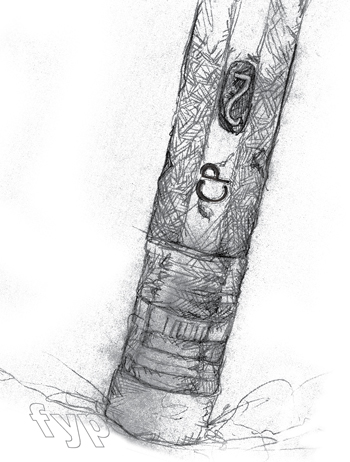With a new title and a more specific focus, the First Year Program becomes its own department
By Tola Brennan
According to Scott Ramon, this isn’t the first time the First Year Program (FYP) has changed. “The First Year Program has been in transition ever since I started ten years ago,” says SAIC’s Director of Undergraduate Admissions. In the last decade, the FYP has gone through some aggressive changes, most of them occurring since 2005. Most recently, the FYP has become the Contemporary Practices Department (CP).
Amy Vogel, Co-chair of the Contemporary Practices Department, explained that when they began reformatting the program, they had to say, “This isn’t quite right for 2005,” and ask, “How do we adapt to that?” Staying contemporary is an important aspect of the SAIC experience. “What’s exciting about SAIC is that it was one of the first [schools] to start changing. Everybody was involved in the curriculum,” Vogel adds.
Jim Elniski, former First Year Program co-chair and current faculty member in the new Contemporary Practices Department, wants first-year SAIC students to be able to stretch the limits their creativity. “The whole issue of creativity has really been: What is creativity? It is an ability which has been re-focused as being a human attribute that has more recently been tied to dispositions that we have as individuals and supporting open-ended exploration of ideas and form, and less about methods and materials.”

This rethinking of the program resulted in Core Studio, the year-long media-based synthesis of the old 2D, 3D and 4D classes. “Rather than studying the foundational principles of surface or 2D and then doing the same thing for 3D, you’ll study them in relation to each other. It’s really coming at art through the making, how you get at ideas through materials,” Vogel explains.
This approach is cemented in the alternate terminology of surface, space and time. “I think that this understanding is a necessity for visual scholars, for people who make things. They need to understand that there’s a bridge between these qualities. The bridge is their idea,” adds Ramon.
The name change was essential to the continuing development of these studies. “Even if we didn’t become a department, we were going for the name change. It just happened to coincide nicely,” says Vogel. The [First Year] program felt like, “this thing you had to get through. ‘First Year’ doesn’t really say what you’re doing in the classes, it’s just a mark of time. The name ‘Contemporary Practices’ felt like a nice move away from the sense that we were just foundations.”
Forming the department began “with some research about students and retention and a correlation [with those numbers with] being taught by full-time faculty. I think that’s why it came down that we were allowed to become a department,” explains Vogel. Being a department enables the hiring of full-time faculty.
However, this came at a price. “All of us had to reapply for our jobs to make room for full-time faculty. We couldn’t keep all of the part-time people.” The process was handled by an undisclosed committee, and was structured according to strict school regulations. “I know it was a very, very tough decision. Across the board it was very hard for all of us. Everyone was in the same boat.”
In regards to the newly-formed department, Vogel says that “it was really painful, and it’s a risk making the name change and everything. But it feels good. There’s a sense that it’s exciting and we’re going to keep discussing stuff. We have faculty lunches and teas where we talk about curriculum and we keep looking at: is what we’re doing right?”
Keeping studies relative to current trends in art is something that they focus on when building the first year curriculum. “We want to keep being able to respond and build on what we already have that’s good, [while also] responding to changes. How do you bring in new technology and still really teach drawing and be fair to that?”
Maintaining SAIC’s inter-disciplinary philosophy was important in the development of the identity of the Contemporary Practices department. “You need to immediately think in an inter-disciplinary manner or you’re not going to make it,” Ramon says. “A lot of people have a very traditional art background. It’s very rigorous in the technical exploration of still lifes or classical studies. There’s not a lot of talk on theory. There’s not a lot of discussion in regard to what’s happening now. People ask: ‘Who’s your favorite artist?’ Are you going to say Van Gogh, Gauguin, and anything you can see on a Wheaties box? To be someone who is a maker in the 21st century you are working in a contemporary context. For some reason, people don’t think that.”
Trial and error is fundamental to the Contemporary Practices department. “A big aspect of CP is this emphasis on learning how to fail and learning how to accept that, and I think most people are not ready to handle it at that age group,” says Ramon. “We’re looking at media holistically — just because something is surface-based, it might be a drawing, but it might involve time and it might involve other elements. It’s more of an open-ended perspective, and it forces you to think about that. It makes sure you’re not going to gravitate towards safety or quaintness of how you work in media. It’s not the most pleasant place to be but you have to be doing that. If you’re not questioning what you do and how you make something, then you’re coloring in a coloring book.”
The program’s name change is more than just a cosmetic enhancement. Rather, it’s reflective of the School’s commitment to keeping the curriculum relevant — consistent with the program’s evolution over the past five years. With a clearer identity, and a new faculty structure, we shall see if the Contemporary Practices Department can deliver where the First Year Program fell short.







